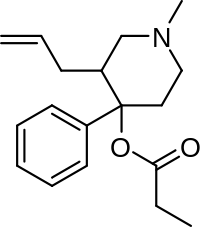Allylprodine
 | |
| Systematic (IUPAC) name | |
|---|---|
| (1-methyl-4-phenyl-3-prop-2-enylpiperidin-4-yl) propanoate | |
| Clinical data | |
| |
| Identifiers | |
|
25384-17-2 | |
| None | |
| PubChem | CID 32938 |
| DrugBank |
DB01542 |
| ChemSpider |
30495 |
| UNII |
4343OEZ18O |
| ChEMBL | CHEMBL2103995 |
| Synonyms | Allylprodine |
| Chemical data | |
| Formula | C18H25NO2 |
| 287.397 g/mol | |
|
SMILES
| |
| |
| | |
Allylprodine[1] is an opioid analgesic that is an analogue of prodine. It was discovered in by Hoffman-La Roche in 1957 during research into the related drug pethidine. Derivatives were tested to prove the theory that phenolic & non-phenolic opioids bind at different sites of the opiate receptor.
Allylprodine is more potent as an analgesic (the 3R,4S isomer is 23 times more potent than morphine) than similar drugs such as α-prodine, due to the allyl group binding to an additional amino acid target in the binding site on the μ-opioid receptor. It is also stereoselective, with one isomer being much more active.[2][3]
Allylprodine produces similar effects to other opioids, such as analgesia and sedation, along with side effects such as nausea, itching, vomiting and respiratory depression which may be harmful or fatal.
1-methyl-3-allyl-4-piperidone
Preparation of this important intermediate is detailed in the attached citation.[4]
n-Propylprodine
This compound is also known to have been made and to have existed. It has happened before.[5]
This compound was tested on rats and found to produce profound analgesia at 8 mg/kg. It produced a 4-aminoantipyrine (Ampyrone) type analgesia at 4 mg/kg, ataxia at 10 mg/kg, prostration at 20 mg/kg, and sometimes death at 40 mg/kg.
They made the 3-benzyl compounds too but these were all inactive in the tests.
References
- ↑ U.S. Patent 2,798,073 - PIPERIDINE DERIVATIVES AND PREPARATION
- ↑ Portoghese, P. S.; Shefter, E (1976). "Stereochemical studies on medicinal agents. 19. X-ray crystal structures of two (+/-)-allylprodine diastereomers. The role of the allyl group in conferring high stereoselectivity and potency at analgetic receptors". Journal of Medical Chemistry 19 (1): 55–7. doi:10.1021/jm00223a012. PMID 1246054.
- ↑ Portoghese, P. S.; Alreja, B. D.; Larson, D. L. (1981). "Allylprodine analogues as receptor probes. Evidence that phenolic and nonphenolic ligands interact with different subsites on identical opioid receptors". Journal of Medical Chemistry 24 (7): 782–7. doi:10.1021/jm00139a004. PMID 6268787.
- ↑ Ziering, A.; Motchane, A.; Lee, J. (1957). "Piperidine Derivatives. IV. 1,3-Disubstituted-4-aryl-4-acyloxy Piperidines*1". The Journal of Organic Chemistry 22 (11): 1521. doi:10.1021/jo01362a053.
- ↑ McElvain, S. M.; Barnett, M. D. (1956). "Piperidine Derivatives. XXVIII. 1-Methyl-3-alkyl-4-phenyl-4-acyloxypiperidines". Journal of the American Chemical Society 78 (13): 3140. doi:10.1021/ja01594a045.